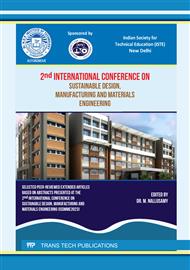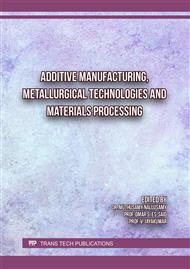[1]
P. Azhagarsamy, K. Sekar, and K. P. Murali, "Nickel Aluminide intermetallic composites fabricated by various processing routes – a review routes – a review," 2022.
DOI: 10.1080/02670836.2022.2062648
Google Scholar
[2]
K. Morsi, "Review: reaction synthesis processing of Ni–Al intermetallic materials," vol. 299, p.1–15, 2001.
Google Scholar
[3]
K. Kehl and K. Morsi, "Reactive processing and properties of nickel aluminide – carbon nanotube composites," J. Mater. Sci., vol. 56, no. 35, p.19501–19511, 2021.
DOI: 10.1007/s10853-021-06462-4
Google Scholar
[4]
A. Skol, P. Kratochvíl, P. Salvetr, D. Deduytsche, and P. Nov, "A comprehensive description of reactions between nickel and aluminum powders during reactive sintering ˇ a," vol. 271, no. January, 2021.
DOI: 10.1016/j.matchemphys.2021.124941
Google Scholar
[5]
C. Hu and W. Chiou, "Multistage Sintering Process for Ni 3 Al Powder Metallurgical Products," vol. 29, no. October, 1998.
Google Scholar
[6]
C. Universite, D. Limoges, and A. A. Thomas, "Reaction process during relative sintering of NiAl," vol. 3, p.2129–2136, 1998.
Google Scholar
[7]
L. M. Peng, J. H. Wang, H. Li, and M. Gong, "Microstructure and mechanical behavior of Ni x Al y – Al 2 O 3 in situ composites by pre-oxidation followed by hot-pressed reactive sintering," vol. 425, p.339–345, 2006.
DOI: 10.1016/j.msea.2006.03.084
Google Scholar
[8]
H. X. Dong et al., "Oxidation behavior of porous NiAl prepared through reactive synthesis," Mater. Chem. Phys., vol. 122, no. 2–3, p.417–423, 2010.
Google Scholar
[9]
K. Yokota, C. Gama, and K. Morsi, "Effects of Preheating by Direct Electric Current on the Self-propagating High-Temperature Synthesis of Ni 3 Al-CNT Intermetallic Nanocomposites," Metall. Mater. Trans. A, vol. 53, no. 8, p.2823–2831, 2022.
DOI: 10.1007/s11661-022-06708-z
Google Scholar
[10]
G. P. Cammarota and A. Casagrande, "Effect of ternary additions of iron on microstructure and microhardness of the intermetallic NiAl in reactive sintering," vol. 381, no. 4, p.208–214, 2004.
DOI: 10.1016/j.jallcom.2004.04.077
Google Scholar
[11]
A. Biswas, "A study of self-propagating high-temperature synthesis of NiAl in thermal explosion mode," vol. 50, p.757–773, 2002.
DOI: 10.1016/s1359-6454(01)00387-1
Google Scholar
[12]
Y. X. Wang, K. F. Zhang, and B. Y. Li, "Materials Science & Engineering A Microstructure and high temperature tensile properties of Ti22Al25Nb alloy prepared by reactive sintering with element powders," vol. 608, p.229–233, 2014.
DOI: 10.1016/j.msea.2014.04.086
Google Scholar
[13]
F. Wenbin, H. Lianxi, H. Wenxiong, W. Erde, and L. Xiaoqing, "Microstructure and properties of a TiAl alloy prepared by mechanical milling and subsequent reactive sintering," vol. 403, p.186–190, 2005.
DOI: 10.1016/j.msea.2005.04.049
Google Scholar
[14]
K. Matsuura, T. Kitamutra, M. Kudoh, and M. Science, "Materials Processing Technology," vol. 0136, no. 96, 1997.
Google Scholar
[15]
M. Okumus, "Study of microstructural , mechanical , thermal and tribological properties of graphene oxide reinforced Al – 10Ni metal matrix composites prepared by mechanical alloying method," vol. 511, no. August, 2022.
DOI: 10.1016/j.wear.2022.204511
Google Scholar
[16]
B. Bülbül and M. Okumus, "Microstructure , hardness , thermal and wear behaviours in Al – 10Ni / TiO2 composites fabricated by mechanical alloying," vol. 281, no. February, 2022.
DOI: 10.1016/j.matchemphys.2022.125908
Google Scholar
[17]
B. Paul et al., "International Journal of Refractory Metals and Hard Materials The studies on the tribological performance , characterization and mechanical properties of W-2Ni-1Fe ( wt %) alloy," Int. J. Refract. Met. Hard Mater., vol. 103, no. September 2021, p.105752, 2022.
DOI: 10.1016/j.ijrmhm.2021.105752
Google Scholar



